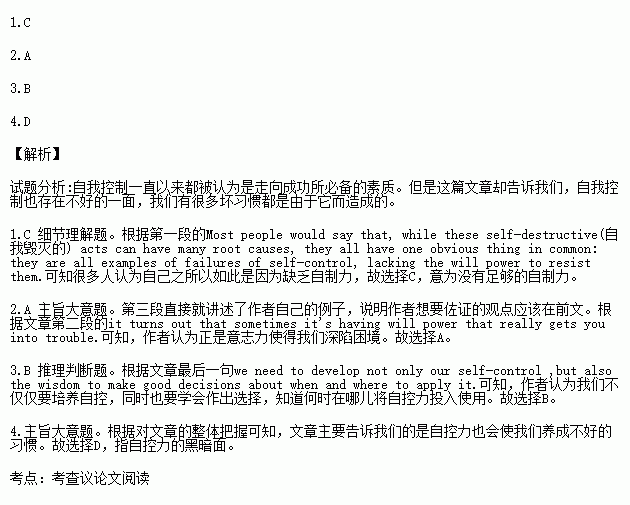题目内容
Why do people drink too much, eat too much ,smoke cigarettes or take drugs? What's to blame for all the bad behavior? Most people would say that, while these self-destructive(自我毁灭的) acts can have many root causes, they all have one obvious thing in common: they are all examples of failures of self-control, lacking the will power to resist them.
According to a recent study, however, if you really think about it, something about that simple answer doesn't quite make sense. In fact, it turns out that sometimes it's having will power that really gets you into trouble.
Think back to the time you took your very first sip(啜饮) of beer. Disgusting, wasn't it? When my father gave me my first taste of beer as a teenager, I wondered why anyone would voluntarily drink it. And smoking? No one enjoys their first cigarette—it tastes awful. So even though smoking, and drinking alcohol or coffee, can become temptation you need will power to resist, they never, ever start out that way.
Just getting past those first horrible experiences actually requires a lot of self-control. Ironically, only those who can control themselves well, rather than give in to them, can ever come to someday develop a "taste" for Budweiser beer, Marlboro cigarettes, or dark-roasted Starbucks coffee. We do it for social acceptance. We force ourselves to consume alcohol, cigarettes, coffee and even illegal drugs, in order to seem experienced, grown-up, and cool.
These bad habits aren't self-control failures—far from it. They are voluntary choices, and they are in fact self-control successes. Self-control is simply a tool to be put to some use, helpful or harmful. To live happy and productive lives, we need to develop not only our self-control ,but also the wisdom to make good decisions about when and where to apply it.
1. What do most people think causes bad behavior?
A. Being forced by others.
B. Enjoying their first experiences.
C. Not having enough will power.
D. Following the examples of their friends.
2.The author mentions his experience in the third paragraph to prove .
A. will power helps develop bad habits sometimes
B. drinking beer is harmful to the health of teenagers
C. self-control should be developed when one is young
D. everyone can be challenged by different temptations
3.In the last paragraph, the author stresses that .
A. without self-control, no one can succeed
B. applying self-control correctly is important
C. bad habits don't always lead to bad results
D. people can develop wisdom from bad behavior
4. What would be the best title for the passage?
A. My First Sip of Beer B. Do You Have Will Power?
C. Will Power Benefits Us D. Dark Side of Self-control

